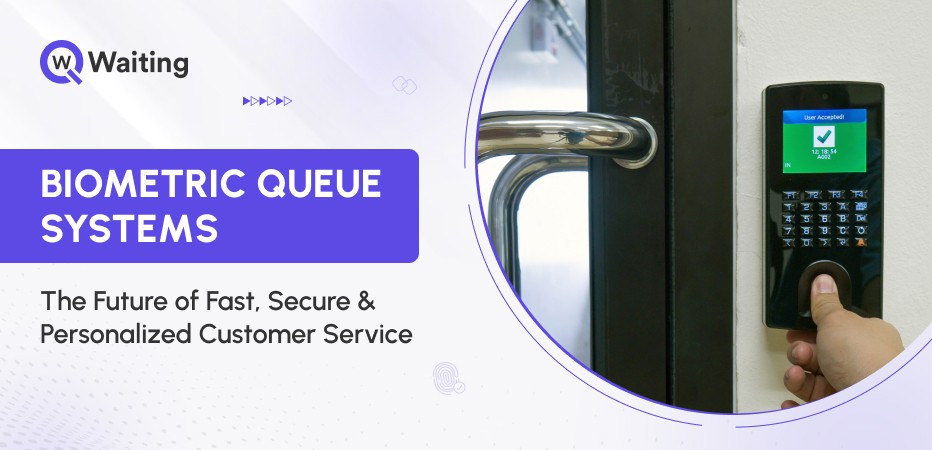
In today’s digital-first world, customers expect services that are fast, secure, and personalized. To meet these demands, businesses are increasingly adopting biometric queue systems that streamline check-ins and optimize the queuing process. By analyzing unique facial features and body movements, these systems not only eliminate identity fraud but also reduce waiting times and create more personalized service experiences.
In this article, we’ll explore how biometric queuing works, why traditional systems often fall short, and how leading industries are already leveraging biometrics to deliver faster, smarter, and more secure customer service.
The Evolution of Queuing: From Manual Chaos to Biometric Precision
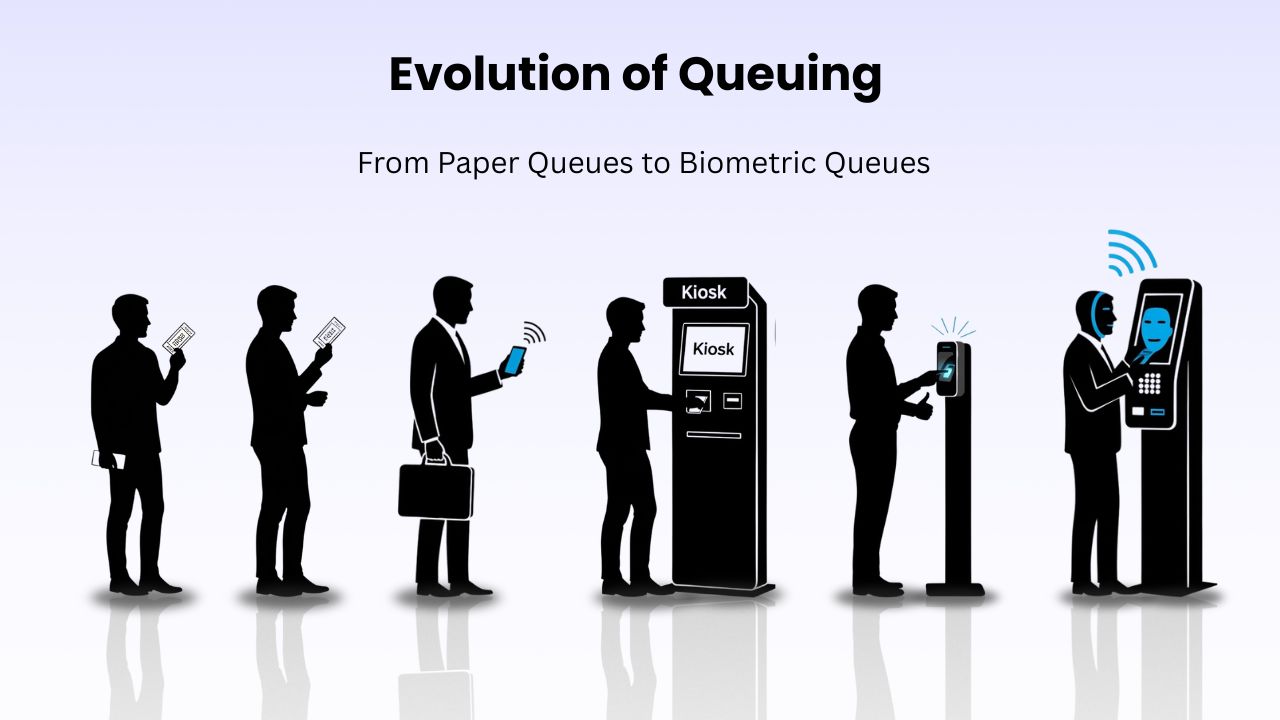
Earlier, queues were managed manually. Customers stood in long lines or took paper tokens, while staff managed everything manually, causing delays, errors, and customer frustration.
With smarter technology, customer flow can be managed faster, safer, and with zero hassle. But to understand why biometrics matter today, we need to first understand what traditional systems lacked.
A Look Back: The Limitations of Traditional Queuing Systems
Conventional queues were served on a first-come, first-served basis. This wasted a lot of time for staff members and led to:
-
Long lines and high walkouts
Scanwatch report claim that 73% frustrated customers often leave a business and walk out if they have to wait at the same place for more than 5 minutes. This ultimately means lost revenue opportunities for businesses.
-
Lack of personalization and tracking
Traditional systems also lacked visibility and personalization. Customers waited in line for their turn, not knowing how long it would take. There were no screens, no live updates, and no way to track their position in line. This lack of communication left both customers and staff frustrated.
Why the Manual Token and Kiosk-Based Systems Are No Longer Effective
Manual paper tokens were once a simple way to register customers, but they quickly became inefficient and outdated as footfall grew and customer expectations rose.
Here’s where these systems fall short:
-
Challenges with managing large footfalls
During busy hours, kiosks and token systems often crash or slow down because they cannot handle the large number of people using them. This causes frustration for both staff and customers.
-
Inaccurate data collection and impersonation risks
Cyberpedia reports claims that token impersonation happens when someone misuses a digital pass or token meant for another user. They use it to pretend they’re that person and access systems or data they shouldn’t see.
This leads to unfair queue jumps and compromises system integrity, and gives a false sense of control.
How Biometric Technology Powers Smarter and Safer Customer Flow
Biometrics rely on unique physical traits, like facial patterns, fingerprints, or iris scans, to instantly verify a person’s identity. These identifiers are nearly impossible to fake, making them a powerful tool for secure and fast authentication.
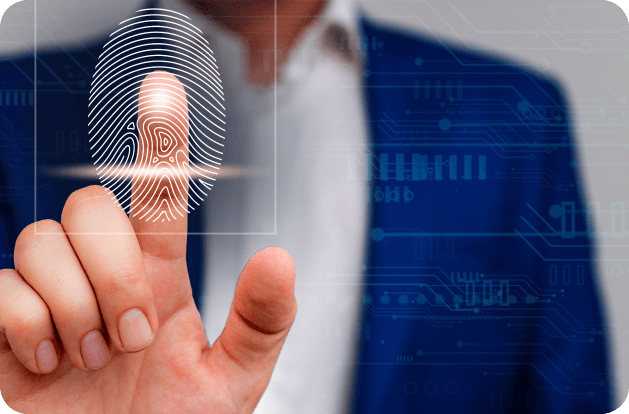
Here’s how biometrics are becoming a safer option for every business and how they help businesses manage their queues and improve services:
Integration with queue management software
When biometrics are integrated with queue management software, the system not only knows who has checked in, it also tracks how long they’ve been waiting, what service they need, and where to guide them next. Everything becomes smooth and seamless.
Contactless and secure check-ins using face/ fingerprint/ iris
In a post-COVID world where hygiene and safety remain top priorities, customers can simply scan their face, fingerprint, or iris without touching shared devices or handling paperwork. This not only speeds up the process but also minimizes health risks and confusion.
From paper-based lines to token chaos, and now to biometric precision, businesses are finally regaining full control over the customer journey. The result is faster service, enhanced safety, and a far more personalized experience.
The Triple Advantage: Security, Speed, and Personalization at Scale
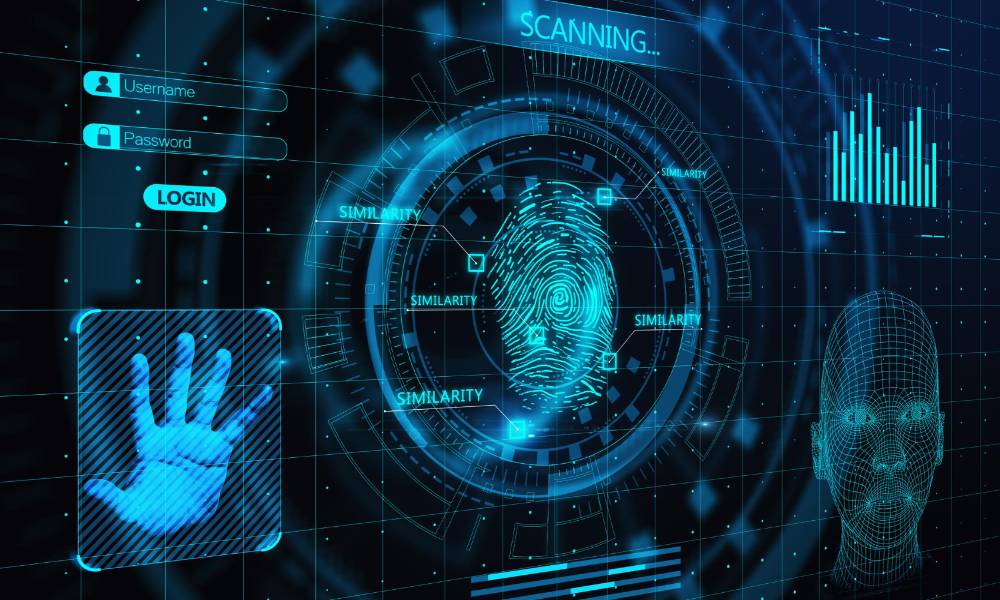
Modern customers expect secure check-ins and personalized experiences. It’s the smarter way for banks, hospitals, airports, and public offices to operate at scale without compromising quality or safety.
Let’s see how biometric security solutions help businesses improve their security, speed, and personalization to serve more customers efficiently:
1. Secure Identity Verification with Zero Human Error
Before biometric solutions, staff members had to check ID cards or rely on what the customer said. Mistakes were common, and fraud was a real risk.
Biometric queuing solutions are helpful as they:
-
Reduce fraud and identity theft
Fingerprints, facial scans, or iris patterns are unique to every person. This means no one can pretend to be someone else, making check-ins much safer.
-
Trusted for secure identity verification
In places like banks, government offices, and airports, where customer identity is very important, biometrics offer a secure, foolproof way to make sure only the right person gets access to services.
2. Faster Processing with Automated Customer Identification
35.1% of customers leave a service due to long queues, and nearly 20% switched to shopping online instead, directly affecting in‑store revenue according to a Systopia report.
By replacing manual processes with an instant biometric check-in system, businesses can serve more people in less time and prevent revenue loss from long queues. Here’s how:
-
Instant customer recognition
Using a biometric verification solution, customer information gets saved automatically based on their past visits. This means customers don’t need to bring ID cards, fill out forms, or repeat personal information.
-
Drop in average service time per customer
When staff don’t have to manually enter data and identification is automatic, queues move faster, staff feel less stressed, and customers leave happier.
Let’s compare some key metrics for a better understanding:
| Metric | Traditional Queues | With Biometric Queues |
| Average Check-in Time | 3–5 minutes | Under 10 seconds |
| Queue Abandonment Rate | High | Very low |
| Identity Verification Time | 1–2 minutes | Instant |
| First-Time Resolution Rate | Lower | Higher |
| Staff Dependency per Counter | High | Minimal |
3. Personalized Experiences Driven by Real-Time Data
The system’s advanced AI-powered memory features automatically update customers’ visit details and their likes/dislikes in the system, which helps staff members provide personalized services and improve service delivery.
Providing a personalized experience is beneficial for businesses as it helps in:
-
Building customer trust
Once a customer checks in, the system shows their past visits, preferred services, and more. This helps staff serve them better and faster, and builds a sense of trust among the users that businesses value their visits.
-
Creates cross-selling and upselling opportunities
By analyzing past purchases through its advanced business intelligence feature, the systems recommend relevant add-ons or upgrades to the customers. This drives upselling, cross-selling, and increases average order value.
How Top Industries Are Leveraging Biometric Queues for Better Efficiency and Security
Whether it’s a bank, hospital, airport, or government office, identification mistakes can lead to data theft, lost revenue, or even lost customer trust.
That’s where biometric queue systems are proven to be a smart and safe way to identify customers quickly and reduce any piracy threats. No need for ID cards, no need to fill out forms, and no chance of someone pretending to be someone else.
Top industries around the world are using these systems to improve how they work. Let’s see how:
Banks
According to a Regula (2024) poll, 50% of banks already use biometric machines to reduce the risk of data theft and Deepfake identities. This indicates that advanced tools are becoming common, trusted, and reliable security measures.
Banks are moving toward biometric queues as they help with:
1. Secure KYC and faster check-ins
Biometric check-ins help banks quickly verify customers during “Know Your Customer” (KYC) procedures. For users, this means faster service with no waiting or paperwork.
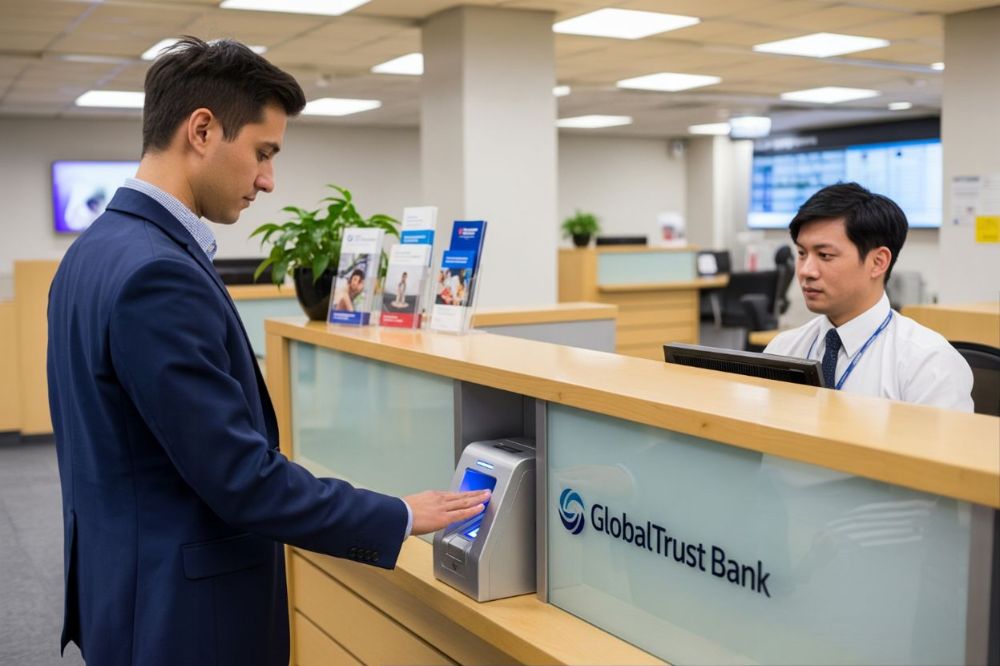
2. Elimination of duplicate identities
Biometric authentication systems scan fingerprints or eyes to ensure that every customer is unique. It prevents one person from opening multiple fake accounts or accessing someone else’s information.
Hospitals
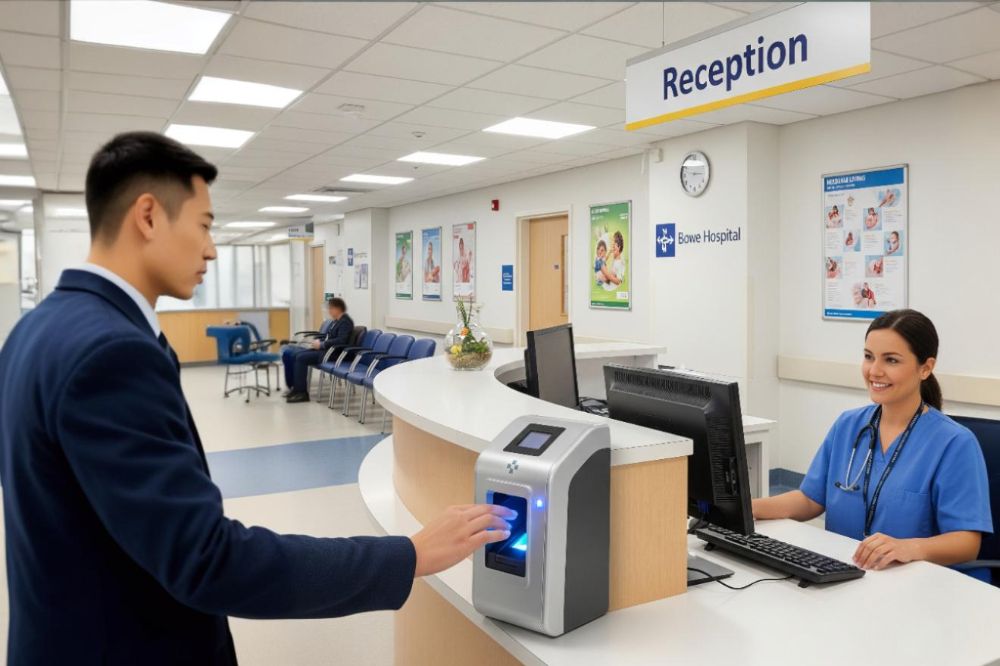
Hospitals need a way to quickly and accurately identify patients, and biometrics are the perfect fit. Here’s how:
-
Emergency room check-ins using facial recognition
Instead of filling out forms or showing ID, patients are identified instantly using facial scans. This helps doctors get straight to treatment, especially when time is critical.
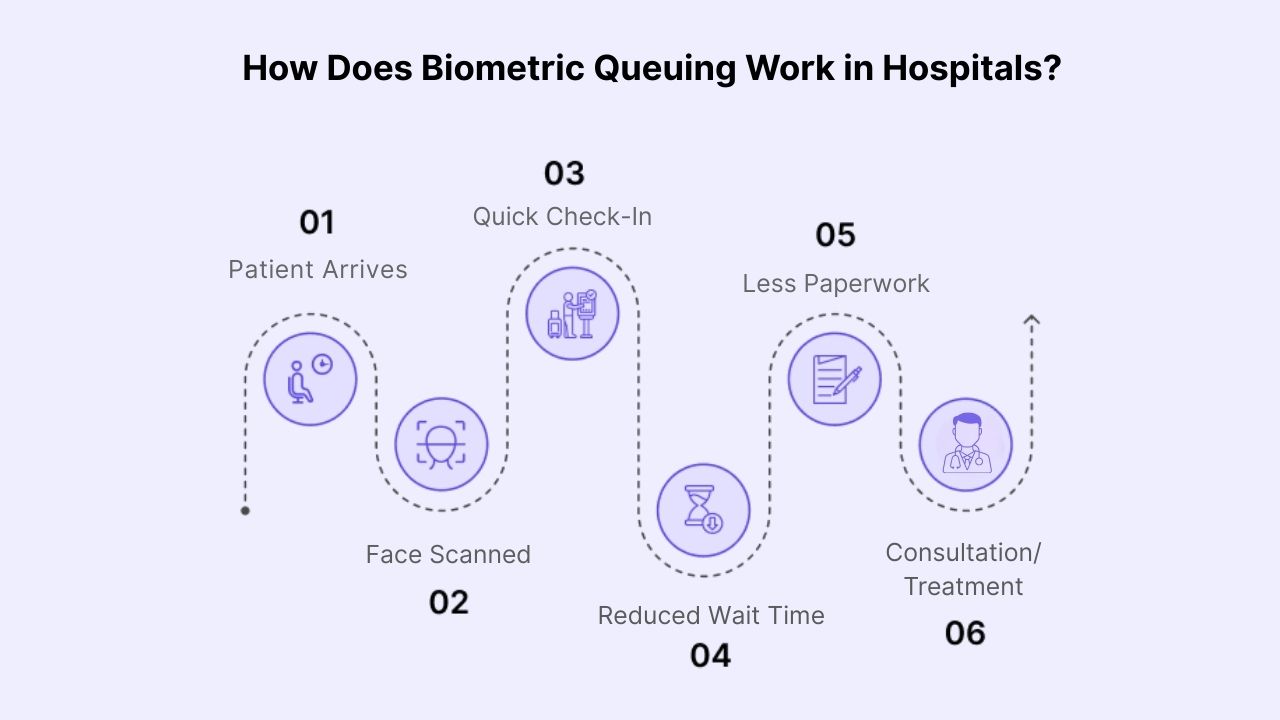
-
Reduced infection risk with contactless tech
With biometric systems, patients don’t have to touch kiosks, pens, or paperwork, helping to keep the hospital environment cleaner and safer.
These systems also help track patient history and medical records without manual searches, making care faster and more reliable.
Airports and Government Offices
Verifying identity, processing documents, and managing queues is a constant challenge at many government offices and airports. Biometric technology is helping such busy places work more efficiently and securely by providing:
-
Border control and multiple licensing counters
Biometric authentication systems are used at immigration desks, passport verification points, and even license renewal counters to reduce paperwork and speed up ID checks.
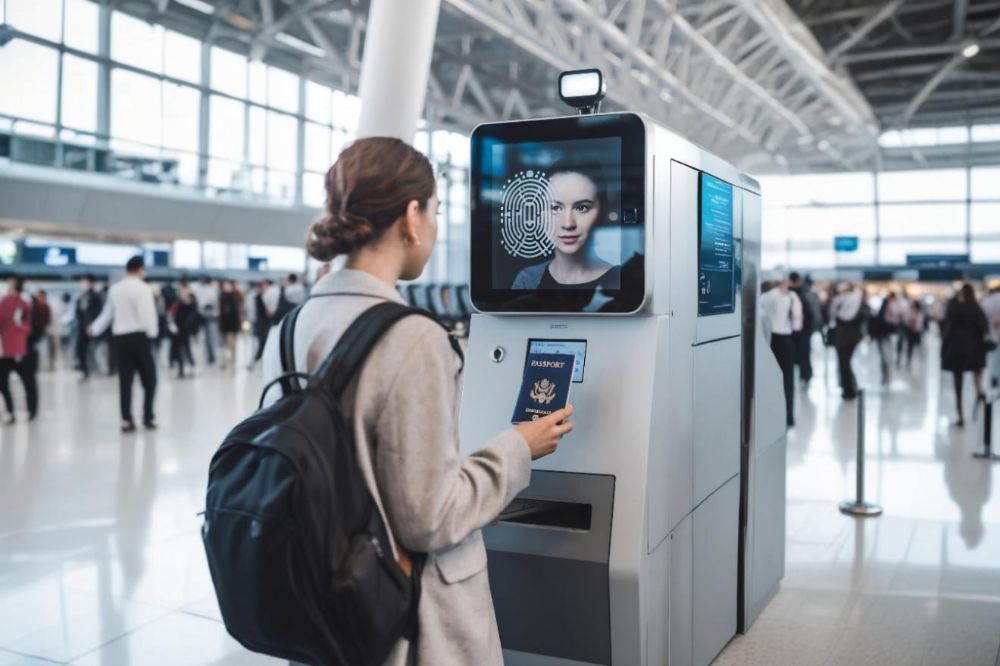
-
High throughput with secure data handling
These systems are built to manage large crowds. Even during rush hours, people move through quickly without compromising data accuracy or security.
Whether it’s checking in for a flight or renewing a government ID, biometrics reduce bottlenecks and make services smoother for everyone. If you want to explore more industries using advanced tools like self-service kiosks or biometrics for secure check-ins, must read our blog: Top 8 Industries Benefiting from Self-Service Kiosks Today.
Implementing Biometric Queue Systems: What Decision Makers Must Know
The shift to biometrics brings great potential and serious responsibilities. There are privacy rules to follow, systems to integrate, staff to train, and customers to keep happy. If implemented poorly, it can create friction and mistrust. But when done right, it can completely change how people experience your service.
This guide breaks it down into simple, clear steps, so you know exactly what matters before investing in a biometric queue system.
-
Choosing the Right Technology Partner
Biometric systems are not one-size-fits-all. What works for a small clinic may not work for a chain of banks or a busy international airport. Choosing the right software partner is the first and most important step. Here’s what to look for:
Scalability
Make sure the system grows with your business. Can it handle five locations today and fifty tomorrow? Don’t settle for tech that limits your growth.
Data Security
Biometric data is highly personal and sensitive. Ask vendors how they protect it, do they use end-to-end encryption, where is the data stored, and who controls access? A secure system builds trust and compliance.
Support and Service
Unlike plug-and-play software, biometric queue systems require ongoing support during rollout, upgrades, and everyday use. Choose a vendor that doesn’t disappear after the sale.
Selecting the best solution from a crowded market is not easy. That’s why advanced queue management software like Qwaiting stand out. With 24/7 customer support, robust security measures, and scalable technology, Qwaiting ensures seamless operations while safeguarding sensitive data helping businesses build efficiency and customer trust at the same time.
-
Ensuring Staff Adoption and Operational Readiness
Even the smartest technology fails if your people don’t know how to use it or resist the change. Adoption is not just about training; it’s about preparing your whole team for a smoother shift.
Begin with the explanation of the “why.” Show employees how the system will help them: get fewer manual jobs, fewer angry clients, and shorter service times. Make them part of the decision-making process and ensure:
- A proper training and Cross-Department Collaboration
- Everyone from front-desk staff to IT should know how the new system works.
- Make sure your biometric system easily connects with existing tools like CRMs or scheduling software.
- Encourage departments (HR, IT, Operations) to work together for smoother implementation.
Biometric queue systems offer a future-proof solution by saving time, reducing contact, and improving customer satisfaction. Careful implementation with the right partner, transparent data policies, and a solid internal strategy ensures successful deployment.
Conclusion
Today’s customers are no longer willing to wait, and industries that still rely on outdated systems are already falling behind in efficiency and security. Biometric queue systems solve both problems by delivering service speed, data safety, and customer service personalization that no paper token or kiosk can match. This is not just a technology upgrade; it’s a competitive strategy.
By implementing biometric queue systems, businesses can protect their brand reputation, maximize operational efficiency, and position themselves as leaders in customer experience.
To secure your customer trust, switch to Qwaiting’s advanced biometric queue management solutions and offer your customers the exceptional customer service they deserve! Because in 2025 and beyond, the winners will be those who treat every customer’s time and identity as priceless and use the technology that respects both.
So, talk to our expert team today and book your 14-day free trial with Qwaiting.
FAQs
-
What are the advantages of using a biometric system for your business?
Biometric systems automate customer check-ins by scanning unique traits such as facial features or fingerprints. This speeds up service, reduces manual errors, and enhances security.
-
How does a biometric security system provide security?
Biometrics uses advanced AI-powered security algorithms and 256 data encryption. This ensures no other person can fake any identity, and nobody can access confidential information without password access.
-
Which industries benefit most from biometric authentication?
Airports, banks, hospitals, and government offices rely on biometrics to manage large crowds, protect sensitive data, and deliver faster services.
-
How do biometrics help prevent identity theft?
Biometrics identifies customers after scanning unique physical traits. Either by scanning thumbprints or an iris scan. Unauthorized users cannot enter the place without proper identification and permission.
-
What is the scope and future market of biometrics?
The future of biometrics will continue to evolve, offering even more smarter solutions to combat fraud and enhance security.
